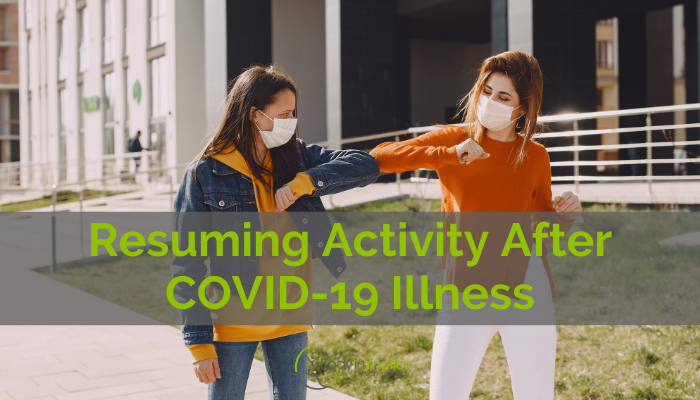
Resuming Activity After COVID-19 Illness
This article is based on guidelines provided by World Health Organisation, John Hopkins Medicine Network, and The Hospital for Special Surgery (HSS) Sports Medicine Institute on how to resume activity post COVID-19 illness.
As far as virulence and unpredictability of viral infections go, COVID-19 is right up there. Not just with symptoms and response, but in recovery and rehabilitation too, wide variance is being observed. The disease affects everyone differently and the impact of long-term effects are still being discovered.
While exercise and movement are therapeutic for illness in general and strongly encouraged, crafting general recommendations/advice for resuming activity and exercise post-exposure to COVID-19 is not easy because of this variance. We now know that the virus can impact multiple organs and systems (heart, lungs, liver, kidneys, musculoskeletal, etc.) and some effects may be silent and/or protracted. Many people have reported breathlessness and high and prolonged fatigue, making resuming activity and exercise difficult. Even otherwise fit and healthy people have not been immune to these challenges.
So for those readjusting to normal life post-COVID-19, what are the guidelines, especially with respect to exercise?
A perusal of recommendations issued by different medical/health publications throws up some key pointers to facilitate the process in those recovering from COVID-19, irrespective of the severity of their symptoms, including those who were asymptomatic.
Exercise Guidelines*
John Hopkins Medicine Network recommends progressive exercising as part of their rehabilitation protocol. Briefly, the classification is as follows:
- Deep Breathing Exercises: lying, sitting, and standing.
- Vestibular Activation Exercises (controls balance and sensory input): These involve moving the eyes and head up and down, side to side; body rolls on the bed; rocking body movements (seated on a chair, standing and rocking on hands and knees)
- Cross Body Movements: Touching right knee/thigh with the left hand, lifting the leg, etc.)
- Strength Building Exercises: Yawn to smile exercise; Bicep Curls; Shoulder elevation and press exercises; Standing heel raises with overhead arm raises; Wall push-ups; Mini Squats, etc.)
- Endurance Building Exercises: Progressive cardio 5 min/10 min/30-45 min
All exercises should ideally be performed with deep breathing.
In conjunction with the above, it is worth considering guidelines published by The Hospital for Special Surgery (HSS) Sports Medicine Institute in New York City, for returning to exercise after living with mild to moderate COVID-19. These touch upon six key areas, relating to symptoms. Briefly stated, the recommendations include:
- Blood (Hematologic) Symptoms: Less sedentary behaviour will reduce the risk of blood clots. Start with gentle, low-intensity exercises.
- Respiratory Symptoms (pneumonia, breathlessness): It’s recommended to wait for at least a week after symptoms subside. There should be a gradual return to activity levels with careful monitoring of breathing effort and response.
- Cardiac/Heart Symptoms: Recommended resting for 2-3 weeks after symptoms subside. Those with suspected Myocarditis (inflammation of the heart muscles), may have to wait for 3-6 months before resuming any exercise regimen. This may need additional testing and requires careful monitoring.
- Gastrointestinal Symptoms (nausea, vomiting, diarrhea, loss of appetite): Monitor fluid and calorie intake while slowly easing into exercise.
- Musculoskeletal Symptoms (aches and pains): Go gradual with exercise intensity.
- No Symptoms: Gradual easing, nevertheless. If no known symptoms for a full week, resume activity at 50% of normal capacity. Pay attention to how your body feels.
*Please see precautions below.
Precautions:
Bear these important points in mind before initiating, and during exercise:
- Consult your physician whether it’s safe to exercise or not.
- Tread cautiously and start slow.
Do NOT exercise if:
- If you have a fever or feeling unwell
- You have difficulty breathing/shortness of breath, even at rest
- You have chest pains, irregular heartbeat, or palpitations
- You have swellings in your legs or extremities
STOP exercising immediately if you develop any of these symptoms:
- Shortness of breath/difficulty breathing
- Chest pain/palpitations
- Dizziness
- Headache
- Nausea
- Excessive fatigue / muscular pain
- Cool, clammy skin
- Swelling in extremities
- Passing out
- Experience vision blurring or tunnel vision
The key to recovery from an illness is to initiate movement and exercise as safely and timely as possible, depending upon your symptoms and body’s response.
Listen to your body, do only what you can handle, and seek your doctor’s advice without hesitation when in doubt.
About Vani Pahwa
Vani B. Pahwa is Health & Wellness Evangelist, and Founder, Body In Motion, who specializes in Functional-Fitness, and Cancer Exercise & Rehabilitation. With almost 2 decades of experience, and certifications from leading internationally-accredited and globally-recognized fitness institutions, Vani is the leading Wellness Expert for Multinational Corporations and is a recognized Speaker and Coach. An Indian Classical Dancer, Vani encompasses her learnings from dance to everyday movement making “exercise and training for life, not just events.” To know more about Vani and her premium wellness services, visit https://www.bodyinmotion.in

Leave a Comment